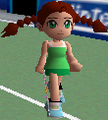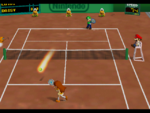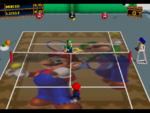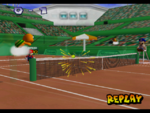Mario Tennis (Nintendo 64)
It has been requested that this article be rewritten. Reason: the writing is substandard and expansion is needed
Template:Articleabout Template:Infobox Mario Tennis, known in Japan as Mario Tennis 64 (マリオテニス64 Mario Tenisu Rokujūyon), is a Nintendo 64 video game. It features Mario and his friends playing tennis, and is the second such game, after Mario's Tennis for the Virtual Boy. It was originally going to be called "Mario's Dream Tennis", but was changed for unknown reasonsTemplate:Refneeded. This game marked the debut of Waluigi, and also Princess Daisy and Birdo's re-entries into the Mario series. The Game Boy Color counterpart is Transfer Pack compatible with Mario Tennis.
Intro
The game begins with the launch of the Mario Star Tournament. Mario and a prominent cast of characters walk out onto the field, where it switches to a walk-through of more playable characters, and a quick zoom in on two shadowed figures. Eventually, the tournament is started and characters are matched up. Mario defeats DK, Yoshi beats Daisy, Princess Peach beats Birdo, and Luigi beats Paratroopa. In the semi-finals, Mario beats Yoshi and Luigi beats Peach.
The finals starts with Mario and Luigi beginning their match by looking for the tennis ball, when suddenly Wario and his new side-kick Waluigi bust in to challenge them. As Waluigi enjoys his new introduction, Luigi exclaims he's not afraid of this new character. Waluigi, now angered, challenges Luigi. Mario tries to calm the two down when Wario confronts him. The four are about to have-it-out, when a gloaming spot-light shines down upon them.
As Toad (who is the announcer) points and shouts, "What's-that!?", Bowser and the hovering Boo fall onto the court below, knocking Wario and Waluigi backwards. Everyone appears disgusted that Bowser would try to ruin a tennis match. To everyone's surprise, the pair announce they have come to play a friendly game of tennis. As everyone is baffled, Mario breaks the silence by exclaiming, "Let's all play!". As Peach and Daisy look to each other and agree, everyone, including Wario and Waluigi, follow suit. Out of nowhere, a Bob-omb makes its way onto the field. Without time to act, everyone is caught in the blast, and the game begins.
Characters
Participants
- All-Around
- Power
Donkey Kong Jr.
(Unlockable)
- Speed
- Tricky
Non-Playable Characters
Basics
Serving
A serve begins each point in tennis. A single player serves each game, and players alternate serving throughout the course of the match. If the player wishes to serve, they must press either ![]() or
or ![]() , then
, then ![]() or
or ![]() again plus a direction on the
again plus a direction on the ![]() to execute the serve. The right timing can result in a "Nice" serve, which is a bit more powerful and quicker than a normal serve.
to execute the serve. The right timing can result in a "Nice" serve, which is a bit more powerful and quicker than a normal serve.
There are three main techniques when serving: Normal Serve, Serving "Out of Bounds", or Serving "Down the Line". Serves are their special shot counterparts. Therefore, if the player double-taps ![]() when serving, they'll hit a topspin serve. Double-tapping
when serving, they'll hit a topspin serve. Double-tapping ![]() on the serve serves a Slice. Holding
on the serve serves a Slice. Holding ![]() and
and ![]() produces the most powerful serve of the game: the Smash serve.
produces the most powerful serve of the game: the Smash serve.
Top Spin
A basic, run-of-the-mill shot in Mario Tennis is the Top Spin shot. This shot has a higher arch to it, curving into the ground after it crosses the net. The player must hit a Top Spin shot by pressing ![]() and aiming with the analog stick. A tail is added to a Top Spin shot by the player double tapping the
and aiming with the analog stick. A tail is added to a Top Spin shot by the player double tapping the ![]() button. This will make the shot a bit more powerful and add an orange fire trail (tail) behind it.
button. This will make the shot a bit more powerful and add an orange fire trail (tail) behind it.
Slice
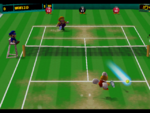
A Slice shot has a lower trajectory and less of a bounce off the surface of the court. The Slice shot is performed by the player pressing ![]() and aiming with the control stick. The player charges their slice shot by double tapping the
and aiming with the control stick. The player charges their slice shot by double tapping the ![]() button. When they do this, a light blue trail (tail) will appear after the ball.
button. When they do this, a light blue trail (tail) will appear after the ball.
Lob
The player can lob a shot over an opponent's head by tapping ![]() , then
, then ![]() . The player can aim with the control stick to bury a lob in the back court. The Lob is especially effective against weaker, quicker players who come to the net. When a player lobs a shot, a star shape will appear where the ball will fall.
. The player can aim with the control stick to bury a lob in the back court. The Lob is especially effective against weaker, quicker players who come to the net. When a player lobs a shot, a star shape will appear where the ball will fall.
Drop Shot
The player taps ![]() , then
, then ![]() to hit a soft shot that glazes over the net and "drops" a few feet from the net. If an opponent is deep on the back court when the player performs the maneuver, they will have to sprint forward to make a play on the ball, which often leads to Mis-Hits.
to hit a soft shot that glazes over the net and "drops" a few feet from the net. If an opponent is deep on the back court when the player performs the maneuver, they will have to sprint forward to make a play on the ball, which often leads to Mis-Hits.
Power Shot

To do a Power Shot, the player must press ![]() and
and ![]() simultaneously. This will send a high-powered blast from the character's racket. The Power Shot is the toughest in the game to return. A Power Shot is especially effective when used at the net. Sometimes, a ball may be returned weakly or on opponent will use a Lob, which will cause a star to appear where the ball will bounce. Using a Power Shot on these stars will result in a powerful Smash. A Power Shot is indicated by a glowing pink energy trail.
simultaneously. This will send a high-powered blast from the character's racket. The Power Shot is the toughest in the game to return. A Power Shot is especially effective when used at the net. Sometimes, a ball may be returned weakly or on opponent will use a Lob, which will cause a star to appear where the ball will bounce. Using a Power Shot on these stars will result in a powerful Smash. A Power Shot is indicated by a glowing pink energy trail.
Charge

The player must press and hold either ![]() or
or ![]() . The player's character will freeze in place and begin to spark, indicating that power-up has begun. A charge-up shot is not only more powerful, but easier to control as well. Once the player begins a charge-up, they will not be able to move until they hit the ball unless they are a "Tricky" character. It is possible to cancel charging if they misaligned the shot. The player does this by tapping
. The player's character will freeze in place and begin to spark, indicating that power-up has begun. A charge-up shot is not only more powerful, but easier to control as well. Once the player begins a charge-up, they will not be able to move until they hit the ball unless they are a "Tricky" character. It is possible to cancel charging if they misaligned the shot. The player does this by tapping ![]() in the midst of their charge-up. Charged shots result in devastating strength and are hard to return if performed correctly.
in the midst of their charge-up. Charged shots result in devastating strength and are hard to return if performed correctly.
Mis-hits
Mis-hitting the ball usually occurs when the player's character doesn't have an optimal approach. Shots fly past the end line, miss wide and fade before reaching the net, or even the ball hitting the net. Mis-hits usually occur when the player is moving toward the net. A common mis-hit is to dribble a ball off of the player's racket after a Slice shot. This happens when they are attempting to Smash a Slice shot on the return. If the player gets hit by the ball, the other team will get a point.
Baseline
From the baseline, the player can boom huge ground strokes and work the entire court. Playing the baseline also allows the player to track down anything the other player throws their way. The baseline works well for slow players (Bowser for example) and more powerful players.
Net
It is best used by quicker players who have a lot of reach. When at the net, the player can stay near the center, but must be ready to move laterally to track down shots that try to get by the player down the sidelines. The player may angle shots to the opposite side of the court their opponent is on, or use different techniques, for example, a drop shot can be very effective in some circumstances, whereas a Topspin may be a better tactic at the time.
Doubles
Doubles is a much different mode than singles. It can either be easier or harder than singles, depending on the players play style and even character selections. The court is split into front and back sections. When the player's serving, it is their responsibility to cover the back. When they are not serving, they get to play the net. When being served to, the player's position will alternate. If the player is receiving the serve, they will play back on the point. If not, they've got the net.
Modes
In addition to the straight tennis matches offered in Mario Tennis, several special play modes are also available which are playable both individually or with another CPU or Player. These modes offer a variety of different matches and minigames that differ from standard tennis, or pre-created tournaments.
Exhibition
The exhibition mode offers the player a match in which they can customise their match. They may choose to either play singles or doubles, the length of the match, the difficulty of the opponent, and the court that they play on. The player can choose five different difficulties, which are Novice, Intermediate, Expert, Pro, and Ace. The player can also choose who their opponent or partner is.
Blue
- 1 Set: Play one set of two games.
- 3 Sets: Play three sets of two games each. This mimics the final round of the Star Cup tournament.
- 5 Sets: Play five sets of two games each.
Green
- 1 Set: Play one set of six games.
- 3 Sets: Play three sets of six games each.
- 5 Sets: Play five sets of six games each.
Once the players have selected the number of games they like to play, an opponent is determined, if playing a one-player contest. The difficulty of the opponent can be adjusted too.
- Novice: Easy difficulty, Triangle marks
- Intermediate: Normal difficulty, Circle marks
- Expert: Hard difficulty, Circle with dot marks
- Pro: Intense difficulty, Star marks
- Ace: MAX difficulty, same as Pro. (Unlocked by beating every cup in simples, including the Star Tournament, by every player except the GBC characters)
After the players' foe has been determined, they must select a court to compete on. If they have unlocked any of the special courts, the courts are displayed here.
Tournament
Mushroom Cup
The first tournament in the game, the Mushroom Cup a standard, basic tournament with easy opponents. The opponents are slow and relatively unskilled. The Mushroom Cup takes place on the Hard Court.
- First Round: 1 Set Match (Novice)
- Second Round: 1 Set Match (Novice)
- Final Round: 3 Set Match (Intermediate)
Flower Cup
Held on the Clay Court, the Flower Cup showcases slightly harder opponents on a harder court than the previous cup. However, the opposition are still not much of a challenge to experienced players.
- First Round: 1 Set Match (Novice)
- Second Round: 1 Set Match (Intermediate)
- Final Round: 3 Set Match (Intermediate)
Star Cup
The Star Cup is the hardest cup of the normal tournaments. The opponents in this cup offer a harder challenge to the player. The court played on is the Grass Court.
- First Round: 1 Set Match (Intermediate)
- Second Round: 1 Set Match (Expert)
- Final Round: 3 Set Match (Expert)
Special Tournaments
There are three more tournaments available in Mario Tennis, which need to be unlocked. To access the Rainbow, Moonlight and Planet Cups, the player needs to win the Star Cup in singles with all 16 characters. Once done, the player must "star" his or her character by pressing and holding the R shoulder button while selecting a player. This will allow the player to participate in the Rainbow Cup. The player has to beat the Rainbow Cup to get to the Moonlight Cup, and win the Moonlight Cup to get to the Planet Cup.
Rainbow Cup
The Rainbow Cup is a slight bit more of a challenge than the Mushroom Cup, yet still not very hard. The only significant difference between this and the Mushroom Cup is strength of the serve. Players here also deal a bit more power with their shots.
- First Round: 1 Set Match (???)
- Second Round: 1 Set Match (???)
- Final Round: 3 Set Match (???)
Moonlight Cup
The Moonlight Cup is a similar to the Flower Cup, except in number of games played. Held on the Clay Court yet again, the Moonlight Cup’s second round is a 3 Set Match, and its final round is a longer 5 Set contest.
- First Round: 1 Set Match (???)
- Second Round: 3 Set Match (???)
- Final Round: 5 Set Match (???)
Planet Cup
The competition level here is the same as that of the Star Cup, albeit much longer in the term of games . Every match leading to the final is a three set match. The final match is a long five sets. The Planet Cup takes place on the Grass Court, like the Star Cup.
- First Round: 3 Set Match (???)
- Second Round: 3 Set Match (???)
- Final Round: 5 Set Match (???)
Ring Shot
The Ring Shot Challenges invites the player to compete in several contests to see how many rings they can collect in various matches of skill. In all except the Game mode, the challenge works like a tie break. The serving alternates every two turns. Three rings appear on the court at a time. Each time the player collects one, another one will reappear on the court. As the player progress through the Ring Shot challenges, they'll receive a number of the same opponents appearing. Probable opponents have been noted for each stage of the four challenges. In multiplayer modes, players and/or teams compete who can get 50, 100, or 200 rings (depending on which of the three is selected). In Doubles Match, the music is different than usual, and players can score rings either in Teams (two players on the same team) or in Battle Royale (individual players per team).
- Game: In Game mode of the ring challenge, the player must collect Rings by playing against an opponent. The player must collect all the rings without winning or losing against their opponent.
- Time: The player must get the required amount of rings in the time specified to clear each challenge. Even if the player misses a ball, they'll get to serve, or be served to again.
- Ball: Keeping the ball in play is the key here, as there is no time limit. In the final Bowser stage, the player will have five balls to work with to get the required score. Fault serves do not count as balls.
- Points: The object of this challenge is to get the required number of points before the time expires. In this stage, rings grow from small to very large. The smallest ones are worth the most, while the biggest are worth almost nothing. This is later used to make Ring Shot in Mario Tennis Open.
Bowser Stage
Bowser Stage takes place on a floating court suspended by chains above a lake of lava. This game is a nod to Mario Kart, where the player can collect and use power-ups against the player's opponent. The court pitches and shifts throughout the match, and the player will have to contend with the weird gravity as a result. Running up it will take the player more time, and the down slope will pull them down toward the lava. The ball also reacts differently to the surface angle.
The other major difference between this and normal tennis are the power-ups that are collected and used. They hover near the center of the net in glowing cubes (similar to Mario Kart) and become the players when they send a ball through one. The power-up then appears in the corner of the screen and can be used by pressing the ![]() button.
button.
Power-ups
- Banana Peel: When the player uses this power-up, a banana peel attaches itself to the ball, then deposited on the court when the ball bounces. This puts a potential slipping spot on the court, forcing the players opponent to play around the peel, lest they slip and fall. However, if the ball does not hit the ground, but is volleyed, the banana has the potential to be placed on the other side of the court.
- Mushroom: Using one of these mushrooms grants the player faster speed.
- Lightning Bolt: When used, a bolt of lightning strikes the opponent, rendering them temporarily dazed.
- Star: Power is increased by the player using a Star. The shots will gain more power and be hard to return if well-placed. Other power-ups can be used with the Star.
- Koopa Shell (Green): The next shot after using this power-up will be followed by a trio of shells, which will temporarily stun the opponent.
- Koopa Shell (Red): This power-up sends out a homing shell that seeks out the opponent and knocks them over for a moment.
Piranha Challenge
The Piranha Challenge pits the player against four opponents: one Mario team player and three Piranha plants. The three plants spit fifty balls randomly, and the object is to return them past the net camper and out of play. The Mario team player stays mostly in the center of the net. If the ball somehow does make its way to the center player, the center player returns it, and it may not count towards the score. There are four courts for the challenge: Hard, Clay, Grass or Composition.
Special Games
Special Games is a special mode including Short Game, Tiebreaker, Ring Tournament, and Demo Mode.
Short Game/Tiebreaker
Short Game is a multiplayer mode where the character or team must score up to 5 points to win the match. Tiebreaker is equivalent to Short Game, except it goes up to 7 points. Short Game and Tiebreaker are only for two players for a Singles Match and four players for a Doubles Match, and never use the computers at all.
Ring Tournament
Ring Tournament is a challenge mode and service for players per copy of the game to have their high scores depending upon how many rings they each collected submitted to the leaderboard with the players' entered names. Before playing, the player was required to enter a code for each of the special cups, including character-based ones. The codes came from the former official website for that game which ran from 2000–2004, and would change from time to time. The service ended in 2004 after the game's sequel Mario Power Tennis replaced it for that URL. This Special Game has been deleted in the Virtual Console re-release of the game.
Demo Mode
In this mode, all of the characters in the Singles Match and/or Doubles Match are computer-controlled, allowing the players to watch the matches as if they were watching a sports event. However, the skill levels for each character cannot be chosen, therefore it is decided randomly which character or team will win the match.
Records
After beating an opponent in exibition or winning a cup, results and trophies are recorded on the Results Screen. Beating an opponent in Exibition mode will result in a shape being placed on a grid, indicating that the player has beaten that opponent. Different shapes mean different difficulties, with a triangle being "Novice" and a star being "Pro".
Courts
Every court plays a bit differently. Each court can be selected for Exhibition matches once unlocked.
Starter Courts
| Picture | Name | Ball Speed | Bounce | Notes |
|---|---|---|---|---|

|
Open Court | Normal | Normal | Only available during Special games. |

|
Hard Court | Normal | Strong | The surface used in the Hard Court yields a higher bounce than other courts. |

|
Clay Court | Slow | Weak | The clay court makes players move much more idly. |
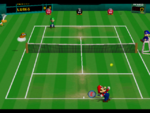
|
Grass Court | Fast | Weak | The grass court yields a lot of low, fast shots. |

|
Composition Court | Fastest | Normal | Not available in any tournament, the composition court is a super-fast surface. |
Unlockable Courts
| Picture | Name | Ball Speed | Bounce | How to Unlock | Notes |
|---|---|---|---|---|---|

|
Mario Bros. Court | Fast | Weak | Win the Mushroom Cup with Mario. | The Mario Bros. Court has a picture of the famous plumbers emblazoned upon it. This surface slightly favors All Around players. |

|
Baby Mario & Yoshi Court | Fastest | Weak | Win the Mushroom Cup with Yoshi. | The Baby Mario and Yoshi Court goes well with speedy players. |

|
Wario & Waluigi Court | Slow | Strongest | Win the Star Cup in doubles with Wario. | The ball is slow but bouncy. This benefits taller and quicker players. |

|
Donkey Kong Court | Fast | Strongest | Win the Mushroom Cup with Donkey Kong. | The court has a super-quick ball and ultra-bouncy surface. This favors power players. |
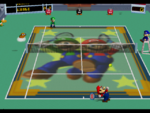
|
Mario & Luigi Court | Fast | Normal | Win the Star Cup with Mario in doubles. | A zippy surface, the Mario and Luigi court is great for a fast-paced match among friends. Power and all-around players will thrive. |

|
Birdo & Yoshi Court | Slow | Strong | Win the Star Cup with Birdo in doubles. | Slow but bouncy. This court favors tall and fast players. (Uses same background as Baby Mario & Yoshi court) |

|
Super Mario Court | Normal | Strong | Win round three of the GBC Mario Tennis minigame, Boo Blast. Then transfer the data through a Transfer Pak. | A court in the sky that features a picture of Mario. (Uses same background as Mario Bros. court) |

|
Peach Court | Normal | Normal | Win round three of the GBC Mario Tennis minigame, Peach Perfect Shot. Then transfer the data through a Transfer Pak. | A secret court built inside Peach's Castle. (Uses same background as Mario & Luigi court) |

|
Yoshi Court | Fast | Strong | Win round three of the GBC Mario Tennis minigame, Fruit Fantasy. Then transfer the data through a Transfer Pak. | A court located on Yoshi's Island. (Uses same background as Baby Mario & Yoshi court) |

|
Wario Court | Slow | Weak | Win round three of the GBC Mario Tennis minigame, Treasure Box. Then transfer the data through a Transfer Pak. | Wario built this mysterious court. (Uses same background as Wario & Waluigi court) |

|
Waluigi Court | Fastest | Strongest | Win round three of the GBC Mario Tennis minigame, Medallion Match. Then transfer the data through a Transfer Pak. | Waluigi customized this court himself. (Uses same background as Wario & Waluigi court) |

|
Bowser Court | Normal | Strongest | Win round three of the GBC Mario Tennis minigame, Two-on-One. Then transfer the data through a Transfer Pak. | A court built on the shadowy world of secret courts. |
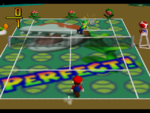
|
Piranha Court | Normal | Normal | Get a perfect score of 50 on the Piranha Challenge. | Only available in the Piranha Challenge. |
Gallery
Staff
- Main article: Mario Tennis (Nintendo 64) Staff
Trivia
- Alex, Nina, Harry, and Kate are no longer playable in the Virtual Console version of the game nor can the characters' personal courts (except for Donkey Kong's) be unlocked in that version as well, because the Wii is not compatible with the N64/GBC Transfer Pak.
- While Waluigi was created for this game as a rival to Luigi, there were talks of a Princess Peach counterpart to further expand the roster. This proposed "Warupichi" (ワルピーチ) character was ultimately dismissed by Shigeru Miyamoto. [1]
- This is the last game that Donkey Kong Jr. appeared in before Diddy Kong took his place in Mario Golf: Toadstool Tour three years later.
- This is also the first game to feature Shy Guy as a playable character.
- Waluigi's eyes glowing while winning would later be reused in Mario Tennis Open.
References
External Links
Template:BoxTop Template:MT64 Template:Mariogames
| Nintendo 64 games | ||
|---|---|---|
| Super Mario franchise | Super Mario 64 (1996) • Mario Kart 64 (1996) • Mario no Photopi (1998) • Mario Party (1998) • Mario Golf (1999) • Mario Artist: Paint Studio* (1999) • Mario Party 2 (1999) • Mario Artist: Talent Studio* (2000) • Mario Artist: Communication Kit* (2000) • Mario Tennis (2000) • Paper Mario (2000) • Mario Artist: Polygon Studio* (2000) • Mario Party 3 (2000) • Dr. Mario 64 (2001) | |
| Donkey Kong franchise | Diddy Kong Racing (1997) • Donkey Kong 64 (1999) | |
| Yoshi franchise | Yoshi's Story (1997) | |
| Crossovers | Super Smash Bros. (1999) | |


















